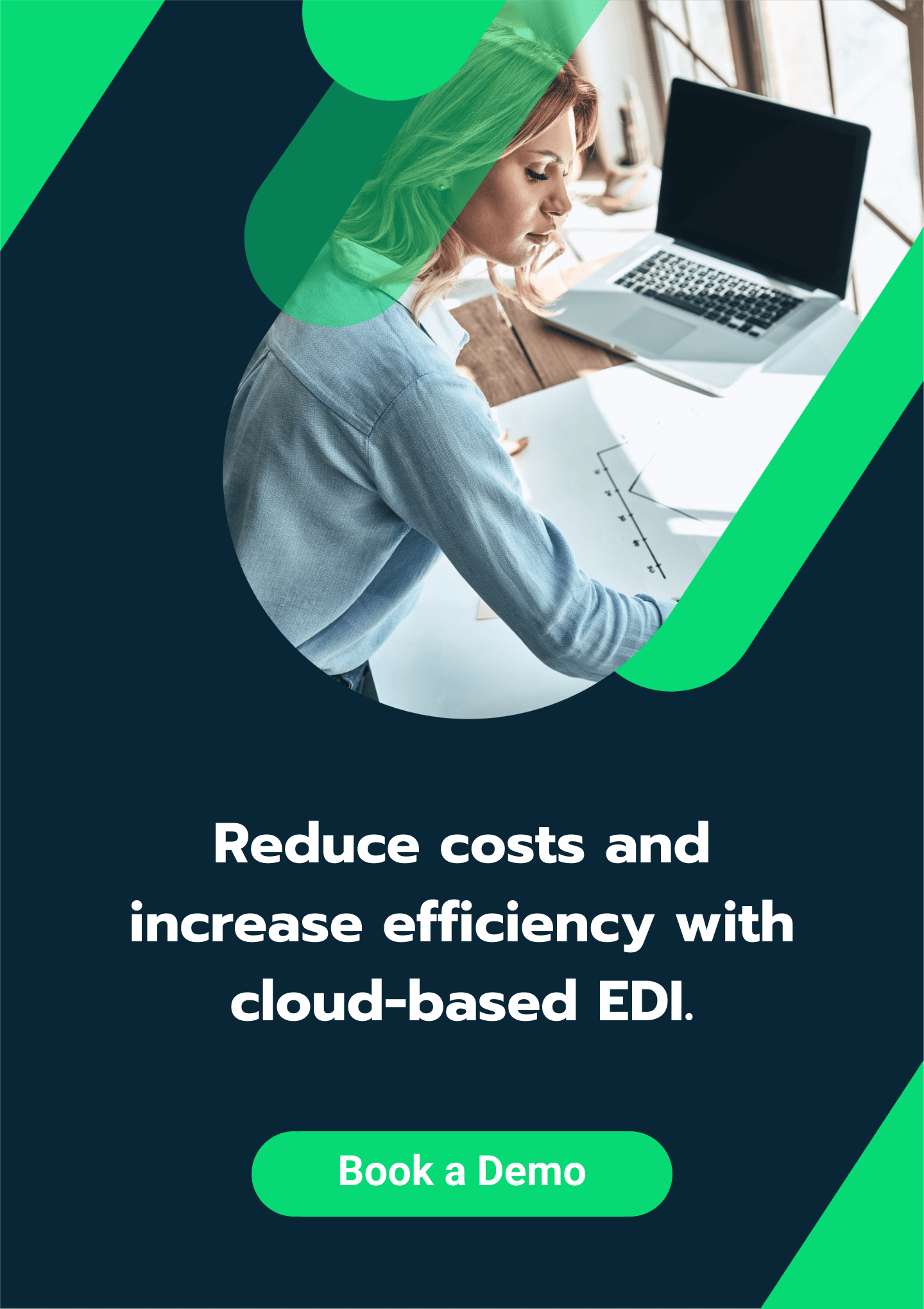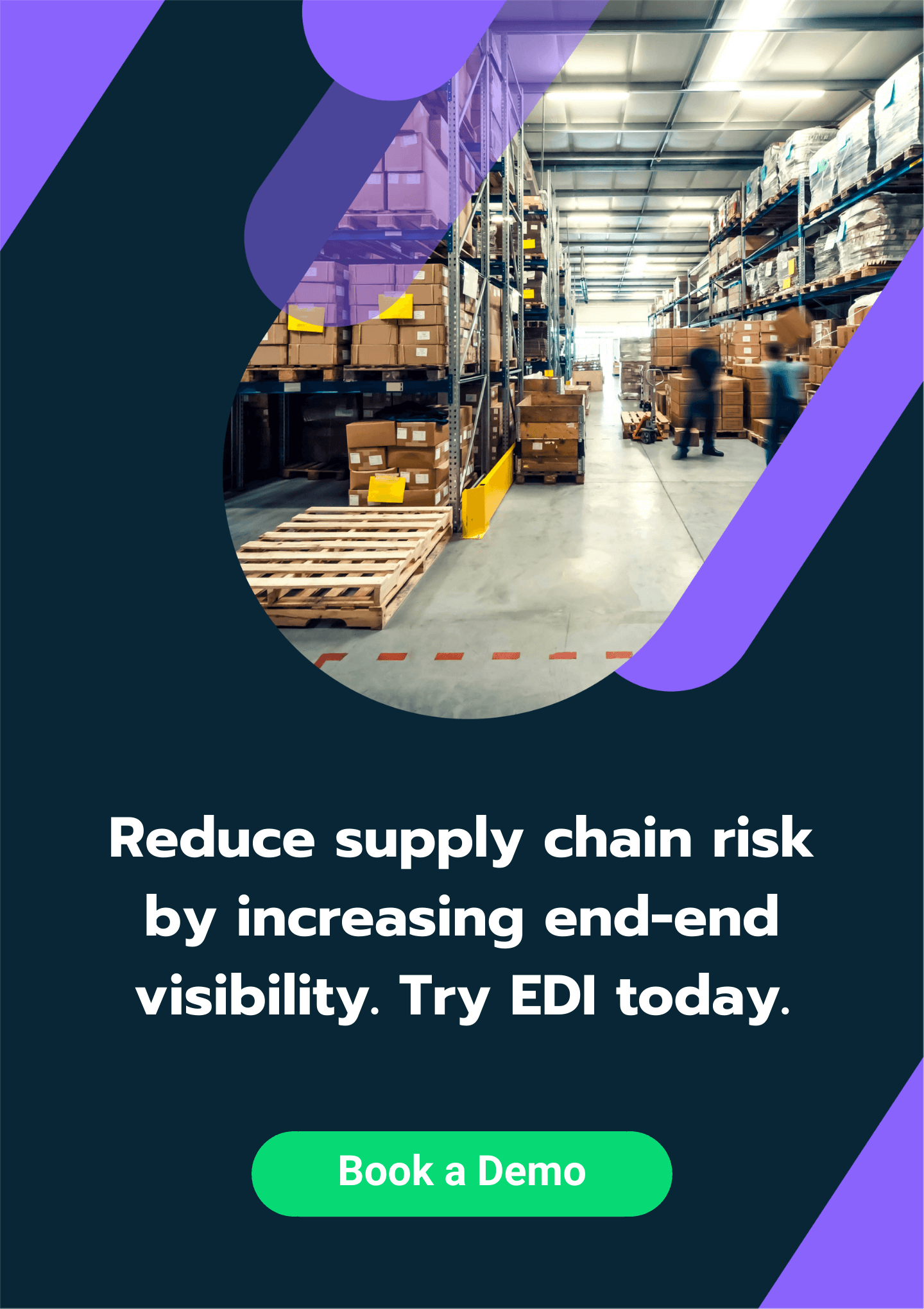How to Overcome Supply Chain Risk
There’s little question that the supply chains are more complex than ever before. Worldwide networks and disaggregated services expose businesses to global and local risks, price shocks, instability and logistical strain. The events of 2020 highlighted the importance of risk awareness and preparing for these factors that cause sudden disruptions to supply chains.
Electronic data interchange (EDI) is the beating heart of effective supply chain management. By facilitating increased visibility and offering more flexibility, EDI sets businesses up to minimise risk and better plan for future scenarios. Although most businesses have some experience with EDI, it’s rarer to see complete adoption — leaving many businesses struggling with EDI implementation issues.
EDI is undergoing something of a renaissance currently — onboarding cloud-based updates that improve accessibility, flexibility and outcomes. EDI-as-a-Service (a hybrid approach combining multiple types of EDI, self-service tools and managed services) not only simplifies the implementation process but improves results, streamlines maintenance and increases adoption rates throughout your supply chain.
For businesses without EDI, adopting a modern EDI solution can deliver a significant boost to business outcomes and risk management operations. For organisations already using EDI, upgrading existing technology and processes can deliver the same favourable results, as well as play a critical role in future-proofing strategies.
Fundamentally, an upgraded approach to EDI is critical to overcoming supply chain risk. But first, it’s important to understand the nature of the risk that businesses face. Let’s get started.
Understanding supply chain risks
Today’s businesses face unprecedented levels of supply chain risk, requiring robust and comprehensive planning. Supply chain risk management is the process by which businesses take strategic steps to identify, assess and mitigate risk events. It’s important to note that these risks can be internal (originating within your organisation) or external (arising outside your organisation).
Internal risks are inherently more manageable than external threats, as they are (at least theoretically) within your control. However, they can still occur suddenly and result in significant supply chain disruptions. These risks include areas such as:
- Manufacturing: Disrupted component(s) of your usual workflow that affect operations and production schedules.
- Business: Changes or interruptions in regular business processes or internal departments, such as management, personnel and reporting.
- Planning & control: Inaccurate forecasting or poorly planned production.
- Mitigation & contingency: Failures to plan and prepare adequately for disruptions.
External risks are more difficult to predict and therefore require more resources to identify, assess and mitigate. Common areas of concern include:
- Demand: Miscalculating product demand, which is often the result of unstable/unpredictable demand or a lack of insight into purchasing trends.
- Supply: Due to raw materials not arriving or not arriving on time, leading to disruptions to larger supply chain flows. This can become even more complex when dealing with multiple third-party logistics (3PL) providers.
- Business & operations: Including sales, mergers and other business-level changes in entities on which you rely to keep your supply chain moving at its usual pace.
- Natural disasters: Including fires, floods and weather events. In 2019, global losses due to natural disasters reached $150 billion (approximately £110 billion).
- Geopolitics: Including trade disputes, tariffs and changes in trade policy.
- Regulatory changes: Including changing transport regulations.
- Cybersecurity risks: Due to potentially weak links in global supply chains, including importers, foreign manufacturers and transport companies.
- Cash flow & financial health: Due to 2020’s government-supported business protection schemes expiring, this is a particularly important trend to watch.
Strategies for responding to risks
The upheaval of the past year has highlighted the need for building reliable, sustainable and flexible supply chains that can withstand any and all of the risks, shocks and threats detailed above.
To address these risks, many businesses operate within a four-stage risk management model:
- Identify: Clearly define and identify elements of risk within your operation.
- Analyse: Categorise identified risks into three states — high, medium and low — based on their probability of occurrence and potential impact on your business. Then prioritise risks accordingly.
- Plan: Implement one or more of the following risk management options: Avoidance (eliminating risk), Reduction (reducing the likelihood of risk, or the impact of risk); Sharing (spreading risk across multiple parties to reduce likelihood or impact); Retention (accepting risk and planning for the financial or resource impacts that are likely to occur).
- Management: Execute, monitor and review risk management action against objectives.
But even within this model, supply chain risk presents a significant strategic challenge. For starters, the supply-based transparency required to carry out these steps can be difficult (and time-consuming) to achieve. Secondly, the scope and scale of internal and external risks are enough to intimidate many decision-makers, while considerations such as probability and severity make it difficult to address, quantify and mitigate risks adequately.
Many businesses default to taking a more reactive approach to their supply chain management because of the challenge of maintaining visibility. However, inefficient preparedness in the face of potential disruptions can cost precious time — and money. In worst-case scenarios, it can result in business collapse.
It’s essential to rise beyond reactivity and face risks head-on, tackling the issues with confidence, insight and structured processes. This begins with cataloguing and continuously monitoring and addressing known risks. Doing so builds the organisational resilience that ensures that your business can carry on in the inevitable event of a disruption.
Ultimately, reducing your supply chain risk and building resilience means becoming a “supply chain centred business”. Centring your business around your supply chain allows you to plan, prepare and respond for whatever comes your way.
Using visibility to create resilience
Building resilience should be the goal of any forward-looking supply chain management strategy this year. And if there’s one fundamental thing to remember here, it’s this: you can’t plan for what you don’t understand, and true understanding requires visibility.
Full visibility gives you a comprehensive view of your supply chain, empowering you to create a more resilient and robust system based on your chain’s specific components. Visibility ensures continuity, agile response times and optimal performance.
Visibility lowers risk by helping businesses:
- Deliver sharper forecast accuracy
- Identify possible disruptions — including supply issues — before they become problems
- Predict potential surges in demand
- Boost sales and operational planning processes
- View both broad and granular pictures of costs
- Manage production and inventory more effectively
How modern EDI delivers unparalleled control
Visibility is the key to overcoming supply chain risk. But the visibility you need is only possible with the right tech tools — which brings us back to EDI.
While many businesses already deploy EDI, it’s important to point out that not just any EDI solution will do the job. To ensure full visibility and total control, you need a high level of adoption across your organisation and supply chain. After all, for each of your trading partners who hasn’t been onboarded into your EDI system, you’re missing a vital piece of the larger puzzle. The more missing pieces, the more difficult it is to gain and maintain a clear picture of the risks threatening your supply chain.
Interestingly, one of the most significant barriers to supply chain tech implementation is knowing where to start. This means that solving this problem before it becomes one requires a flexible, easy-to-use solution that can accommodate evolution and change. Taking a hybrid approach to EDI adoption through EDI-as-a-Service ensures that your system is effortless for your trading partners to adopt, even those with limited EDI skills.
EDI-as-a-Service also delivers visibility and control by:
- Promoting information accessibility: With cloud-based tools, the data in your possession is easy to access and therefore easier to interpret, as it’s not only digital but also accessible from a single portal. Straightforward access to your data sources helps you develop a deeper understanding of the risks facing your business and build more effective response strategies.
- Offering sharp reporting tools: Reporting is a critical component of forecasting, which allows you to perform risk assessments and make more informed strategic decisions. Cloud-based tools with real-time reporting and customised dashboards deliver, within a system that’s equally useful and efficient.
- Providing built-in flexibility: Hybrid EDI tools enable you to onboard new partners at a moment’s notice — an invaluable feature when unexpected disruptions occur.
- Facilitating smoother communication: Easy-to-adopt and easy-to-use tools allow you to improve business relationships and communicate more efficiently across your supply chain, setting you up to mitigate and proactively respond to potential risks.
Building a simplified and stable supply chain
As the global business landscape grows riskier, supply chain visibility grows ever more essential. Gaining and maintaining visibility over your supply chain can dramatically reduce your overall risk level, as well as improve your ability to plan around risk. EDI-as-a-Service delivers this all-important visibility. But in addition to helping you minimise risks, the right EDI solution can also deliver simplicity, create efficiencies and drive better business outcomes. Picking the right EDI managed service provider can help you capture those outcomes today.
Of course, some level of risk will always remain present, that’s the nature of the game. And having the visibility delivered by EDI is only a starting point — it’s up to you to transform the insights you gain into a positive, proactive risk management strategy.

































































































































